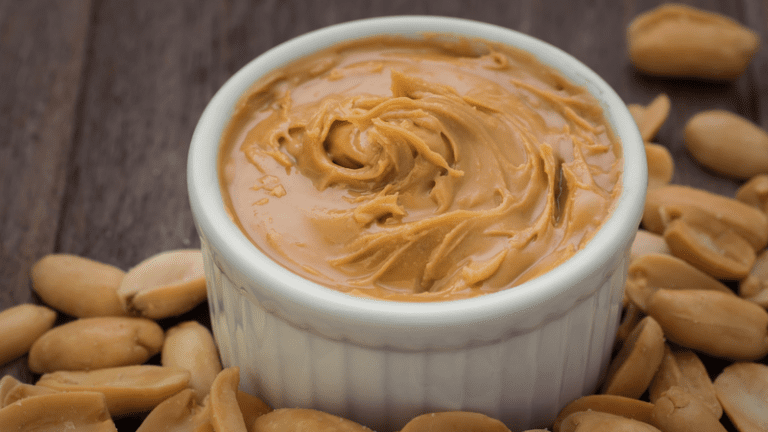In my humble opinion, peanut butter (PB) is one of the best sports foods around. Not only is it delicious, it is also health-promoting and performance enhancing. A review of the research on peanuts validates why I routinely choose to enjoy two (!) PB sandwiches a day: one for lunch and the other to curb late-afternoon hunger.
If you are among the many athletes who try to stay away from peanut butter because it is fattening or too fatty, think again and keep reading (as long as you are not allergic to peanuts, that is). The purpose of this article is to educate you about the value of PB in a diet for sports-active people of ages and athletic abilities—as well as their parents and grandparents.
- PB is not inherently fattening. While any food eaten in excess can be fattening, people who eat PB (and nuts, for that matter) five or more times a week are not fatter than nut avoiders. A Purdue University study (1) reports subjects who ate peanuts daily did not overeat total calories for the day. That’s because peanuts and PB are satiating; they help you feel pleasantly fed. Peanut eaters tend to intuitively eat less at other times of the day.
- PB offers many health benefits. The fat in PB is primarily health-promoting mono- and poly- unsaturated fat that knocks down inflammation. People who eat PB and nuts five or more times a week have lower markers of inflammation than nut avoiders. For athletes who get micro-injuries every time they train, an anti-inflammatory food such as PB is a wise choice.
- Compared to nut avoiders, unhealthy women (with type 2 diabetes) who ate 1.5 oz. (250 calories) of peanuts (and/or nuts) five or more times a week reduced their risk of heart disease by 44% and the risk of having a heart attack by 60% (2). Routinely swapping a burger for a simple-to-make PB sandwich is a heart-healthy choice.
- PB, like all sources of plant protein, reduces that risk of developing Type II diabetes. A breakfast with PB offers a positive “second meal effect.” This means, it helps control blood glucose through lunchtime and into the afternoon. Stable energy—and a reduced desire to eat. (3)
- The fat in PB helps absorb the fat-soluble vitamins A, D, E and K. You want to include some (healthful) fat in each meal; PB is a painless way to do so!
If you are an endurance athlete, such as a marathoner or cyclist, you’ll optimize your sports diet by eating at least 0.5 grams fat per pound of body weight.
The body stores some fat within muscle cells and uses it for fuel during extended exercise. PB in oatmeal before a long bike ride or a PB & J sandwich on a long bike ride are yummy and healthy ways to enjoy adequate dietary fat. Fat-phobic athletes (who avoid fat) can hinder their endurance.
- PB is a good source of arginine, an amino acid that helps keep blood vessels flexible so that blood flows more easily and reduces blood pressure. The more PB you eat, the bigger the effect on health protection.
- What’s good for the heart is also good for the brain. Research suggests PB eaters improve their brain-blood circulation and mental function. This contributes to enhanced processing speed and better short-term memory (4). Plus, a diet rich in healthy fats helps slow cognitive decline. Given the risk of developing Alzheimer’s disease increases exponentially with age, eating PB and nuts today is a wise investment in your future brain health.
- Peanuts offer slightly more protein than nuts. That’s because peanuts are a legume (like lentils and dried beans) and not a nut. One serving (2 tablespoons) of PB has 8 grams of protein, while 2 Tbsp. almond butter has 6 grams (at a much higher price!) Athletes want to target about 20 grams of protein per meal or snack. You can get that by swirling PB into oatmeal cooked in (soy) milk, enjoying a PB & honey sandwich with a yogurt, or making a PB-banana smoothie. Quick, easy, and inexpensive.
- PB contains numerous bioactive compounds (phenols) that bolster the immune system. Spanish peanuts and shell peanuts are particularly wise snack choices because the peanut skin is rich in anti-oxidants and fiber. Fiber feeds gut-bacteria (your microbiome); these bacteria strongly enhance your immune system, overall health and mood.
- All peanuts are non-GMO and have low risk of pesticide residue, in part because peanuts grow under the ground.
- Is all natural peanut butter far better than Skippy of Jif? All types of PB need to meet a “standard of identity” as defined by the USDA. Conventional brands might have 2% added saturated fat (palm oil, hydrogenated oils) to control the oil from separating. This small amount does not over-ride the positive health benefits of PB.
- What about all the sugar added to Skippy and Jif PB? “All” that sugar is only 2 or 3 grams. That’s nothing compared to the 10 to 15 grams of sugar in the jelly or honey you might enjoy with the PB, or the 6 g sugar in the sandwich bread. Regardless, sugar fuels your muscles. Please fret less about added sugar and focus more on PB’s zinc, folate, vitamin E, niacin, and selenium. It is nutrient-rich.
- What about all that sodium in PB? The 150 mg. sodium in a serving of PB is less than the sodium you get in one slice of bread or 12-ounces of Gatorade. Regardless, as an athlete, you want to replace sodium you lose in sweat.
- But what if I can’t eat just one spoonful…? If you stay away from PB because you can’t eat just a reasonable serving, think again. Overindulging in PB means you like it; you should eat it more often! By enjoying PB at every meal, in a few days, you will stop craving it. No more binges!
Avoiding peanut butter just sets you up for “last chance eating.” You know, I just blew my diet by eating PB so I’d better keep eating it. Last chance before I go back on my diet. Denial and deprivation of PB lead to overeating. Do not deny yourself of this yummy sports food. You will deprive your body of valuable health benefits!
Sports nutritionist Nancy Clark MS RD CSSD has a private practice in the Boston-area (Newton; 617-795-1875), where she counsels both fitness exercisers and competitive athletes, teaching them how to eat to win. Her popular Sports Nutrition Guidebook, and food guides for marathoners, cyclists and soccer are available at nancyclarkrd.com, as well as information about her online workshop and teaching materials.
———————————————-
CoachUp is the safest and easiest way to find a coach for personalized training. With our 100% money-back guarantee and vetted coaches, anyone can achieve their full athletic potential. Find your perfect coach today and become the athlete you want to be!
(1) Alper, Int’l J Obesity 26:1129, 2002)
(2) Li, Nutr 138(7):1333-8
(3) Reis, Br J Nutr 109(11):2015-23, 2013
(4) Barbour Nutr Neurosci July 7:1-8, 2016
How useful was this post?
Click on a star to rate it!
Average rating 4.7 / 5. Vote count: 7
No votes so far! Be the first to rate this post.




One Response
I eat Peanut Butter easily 3 – 5 times a week.
I often told Marines that I trained or lead about the benefits of Peanut butter. I tell my son who is training to be a college level football player the benefits of Peanut butter a few times a week. He enjoyed the taste of peanut butter and jelly so I have told him for years that a sandwich and a 1/2 is good for energy, strength and weight gain. I am so glad that this article was posted. Thank you 😎